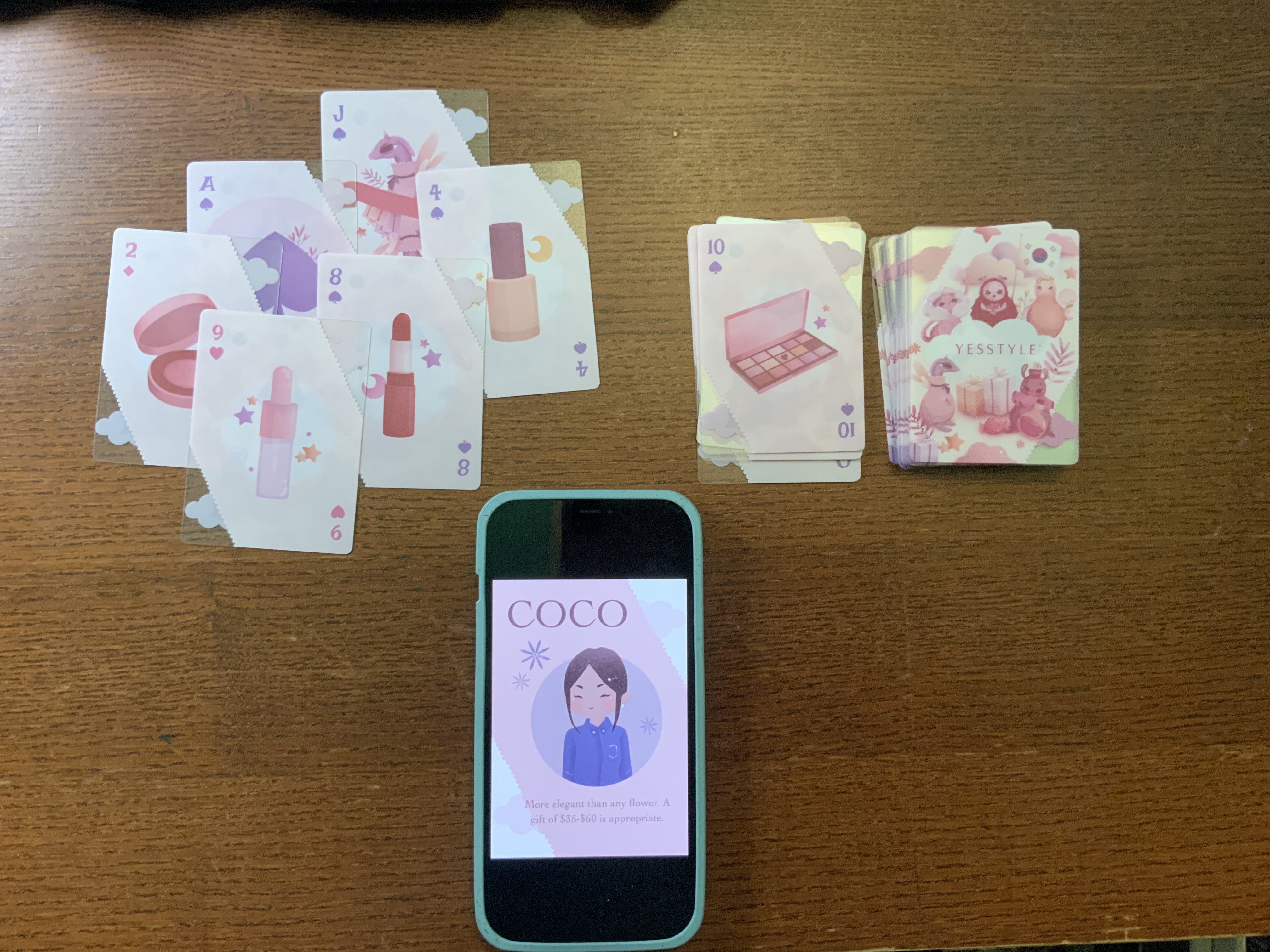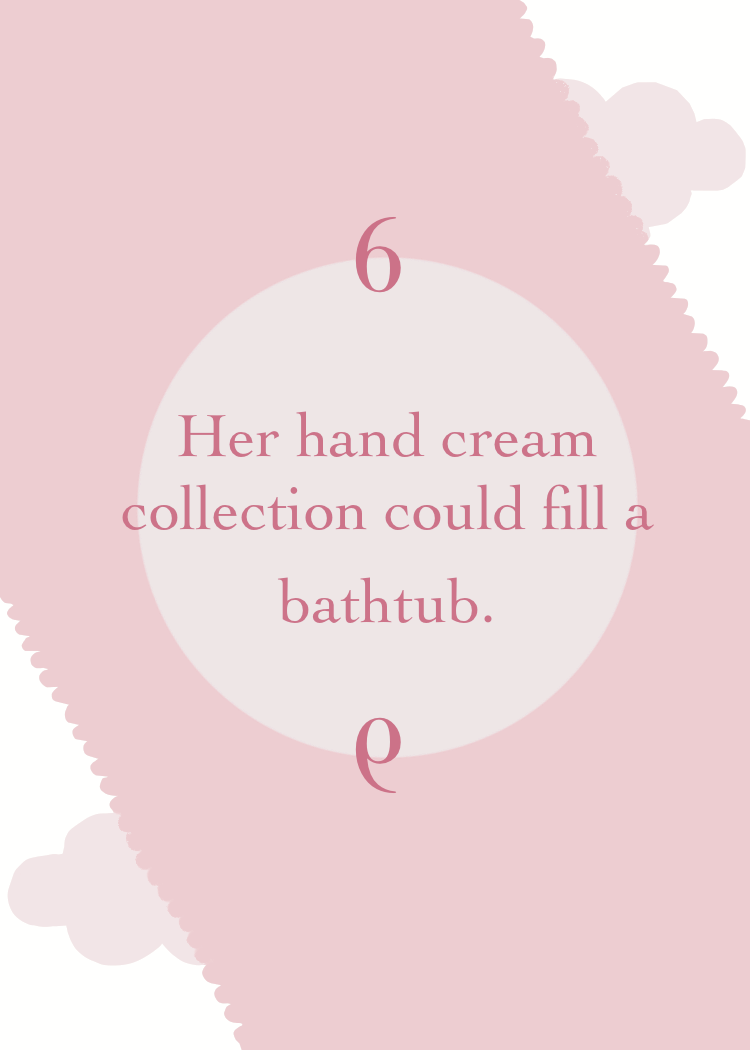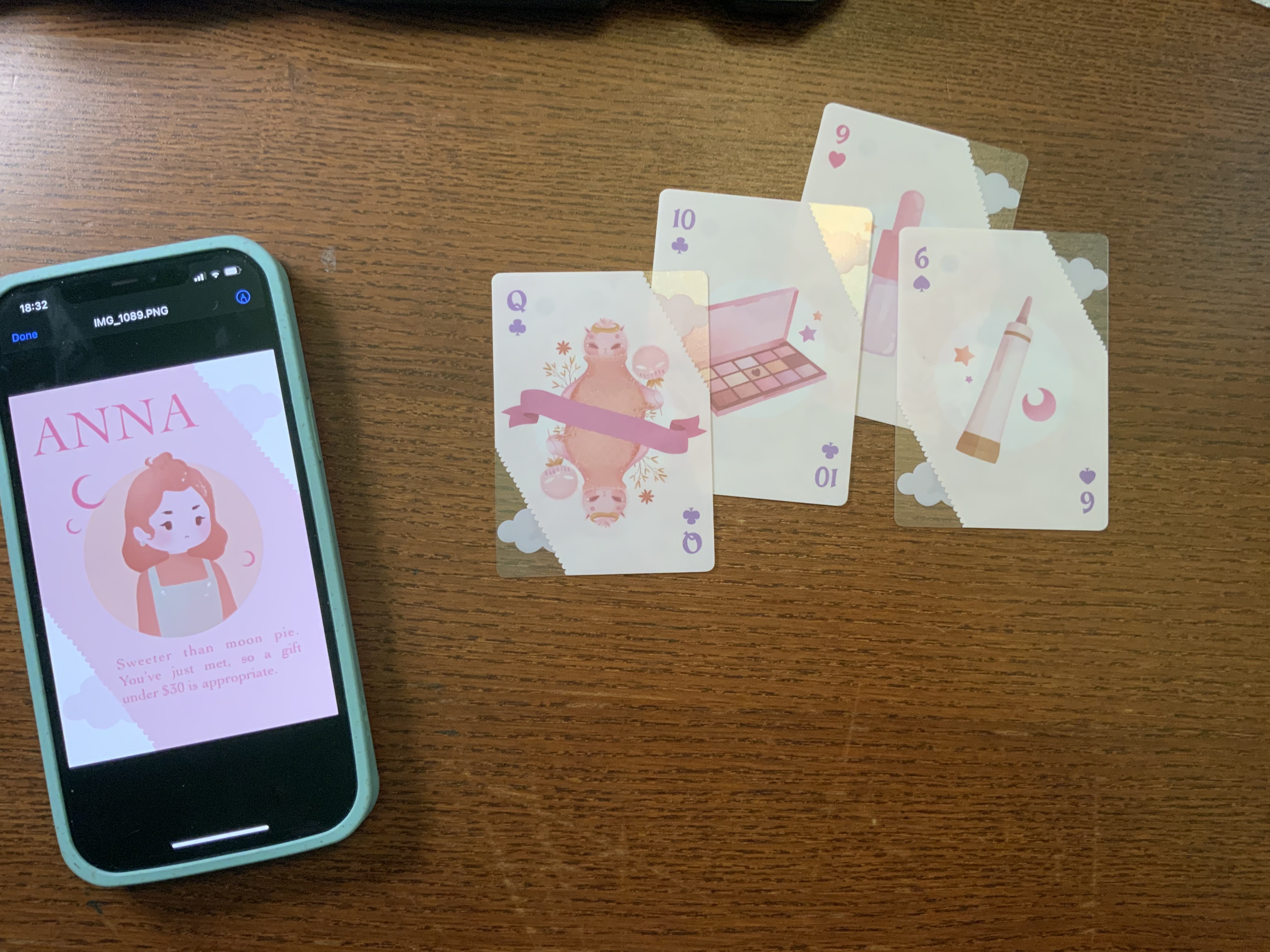 Round 1: Coco, who doesn't like powder puffs (7) $35 exactly, a very lucky round. For reference, the two decks on the upper right are the face-up pile and the discard pile.
Round 1: Coco, who doesn't like powder puffs (7) $35 exactly, a very lucky round. For reference, the two decks on the upper right are the face-up pile and the discard pile.The deck I borrowed from my sister for this project was a standard deck of 54 (Jokers included) that had been a Black Friday gift from a Korean retailer. The card designs were very consumer-based, with numbers in the suits represented by lipstick, eyeshadow, blush, and similar objects. The kings, queens, and jokers were represented as whimsical little creatures, perhaps mascots of the retailer.
As my family does not play card games, I did not know any standard deck games and did some research before settling on Pyramid, or Solitaire 13. Pyramid is a pairing-based single-player game. Cards are laid out in seven overlapping rows, each row with one more card than the previous. The remaining cards form the draw deck. The goal is to pair as many exposed cards that add up to thirteen as possible, the game ending when there are no more cards in the pyramid and/or draw deck. It is appealing because the rules are fairly easy to learn (and fit to various themes) and rounds are quick, so one loss can easily be amended by another victory.
I decided to alter the rules slightly to create a shopping simulation. Since the cards are from a Black Friday deal, I thought creating girlfriends to shop for during the holiday season, each with unique requirements, would be interesting. In the interest of time, I only designed eleven extra cards, three of which were girlfriends and eight of which were product preferences.
There is only one goal in Solitaire 13: to have no cards remaining in your pyramid. In my altered version, your girlfriend wants you to spend a certain amount of money, and may already have too much lipstick or blush. This creates a lot more variety in the outcome of the game, making it possible to still win/satisfy your girlfriend with cards left in the pyramid. Here, the numbers of the cards represent dollars.
Additionally, the original game does not incorporate the Joker cards. I decided to include them in this version as wild cards, in the sense that you can pair them with any exposed card for a monetary cost.
The Rules
Designing the Girlfriend Deck
As my time was limited, I set wide price ranges for each of my three girlfriends. However, even if more characters were created for this version of Pyramid, I believe it would be too frustrating to try to win the game with a narrower range of money spent.
For the preference deck, I decided to only have a dislike of one makeup product. In the deck illustrations, there was eight products total, making for eight cards in the preference deck. If the deck was to be expanded, possible cards may have combinations of dislikes or products that the girlfriend really wants.
Design-wise, I only designed the face-up sides. I did not design the backs because the backs of the standard deck were very intricate and difficult to replicate. Although I do not think that having the same back designs for both the standard deck and the girlfriend deck is a good design choice (since they might easily be confused that way), I believe the girlfriend deck backside would warrant a similarly intricate back design to fit the overall theme.
I used the same basic pattern of the face-up cards from the standard deck, which is a sideways lace/cloud pattern with a center image. Instead of a center makeup product/magic creature, I placed the girlfriend/description of their gift preferences. I drew directly from the color scheme of the original deck, which consists of peach, pink, and magenta tones. To fill up empty space, I also placed small geometric shapes such as crescents or hearts, similar to the deck design. Finally, to emulate a similar feeling to the original illustrations, I used a gradient method of shading and lineless art. The magical creatures in the original deck were rounded and soft, so I tried to apply a similar aura to my characters.
For the font, I could not find the font of the brand, so I chose Cochin, which looked similar. To emulate the all-caps brand logo on the standard deck backside, I capitalized the titles. The sideways lace background created some visual issues since the text was straight and looked out of place. However, I could not figure out how to curve the text. I also purposely chose short names for the characters, as you can easily tell what kinds of formatting problems would arise otherwise.

Playtesting
I played some test runs, then a round for each of the girlfriends. Because my printer was out of ink, I used my phone as a stand-in and used a random number generator to pick the preference card of each girlfriend. I quickly realized that having a certain makeup product that the girlfriend did not like remaining in the pyramid was a terrible way to lose the game and hard to strategize against. I therefore instituted a monetary penalty. For products Anna does not like, there is a +$15 penalty. For Qing and Coco, a -$15 penalty. This is based on their price ranges.
 Round 1: Coco, who doesn't like powder puffs (7) $35 exactly, a very lucky round. For reference, the two decks on the upper right are the face-up pile and the discard pile.
Round 1: Coco, who doesn't like powder puffs (7) $35 exactly, a very lucky round. For reference, the two decks on the upper right are the face-up pile and the discard pile.
 Round 2: Anna who dislikes hand cream(6)$52, over by $17.
Round 2: Anna who dislikes hand cream(6)$52, over by $17.
 Round 3: Qing who has too many lipstick(8)
Round 3: Qing who has too many lipstick(8)
The lipstick penalty actually helped slightly here, resulting in $108 spent. Both jokers were played, adding an additional sum of $45. However, the remaining lipstick in the pyramid added a -$15 penalty.
Final Thoughts
I believe the scenario of shopping for a girlfriend adds some fun to Pyramid, but I definitely got tired pretty quickly of the repetitive pairing actions. There were also a limited number of strategies, such as using the Joker to boost your total cost if you were under your goal. With more characters and personal preferences to choose from, this problem might be rectified. It did seem like the randomness of the cards made winning with any girlfriend’s price range equally likely, although it may be slightly more difficult with Anna/other lower-price characters. This version of Solitaire is likely intended to pass away a short while of time, not to engage a large party. Overall, I enjoyed devising alternative playing methods and especially enjoyed designing new cards. There is certainly a lot more to playing card design that meets the eye.